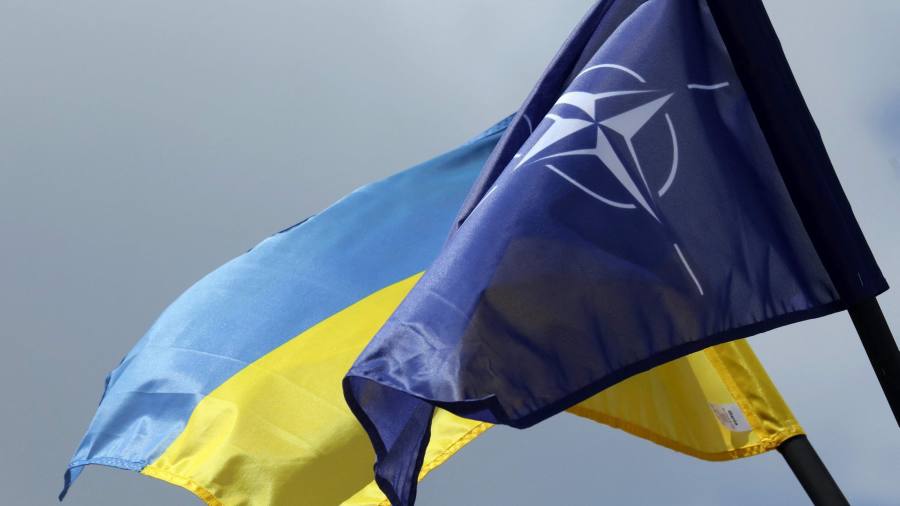Receive free War in Ukraine updates
We’ll send you a myFT Daily Digest email rounding up the latest War in Ukraine news every morning.
The US and Germany are under intense pressure from other allies to show greater support for Ukraine’s eventual membership of Nato, just days before the military alliance’s leaders meet in Lithuania.
Washington and Berlin have backed a form of words for the summit’s concluding statement that does not fully endorse a “pathway” to Nato membership, let alone invite Kyiv to join once the war is over — as demanded by Ukraine’s staunchest supporters in eastern Europe.
Other members of the alliance were caught off-guard by the “conservative” US and German stance, officials briefed on the talks told the Financial Times.
On Sunday US president Joe Biden doused Kyiv’s hopes of a breakthrough on membership, saying he did not think Ukraine was ready.
“I think we have to lay out a rational path for Ukraine to be able to qualify to get into Nato,” Biden told CNN. It was “premature” to “call for a vote . . . now”, he added “because there’s other qualifications that need to be met, including democratisation and some of those issues”.
Russia’s full-scale invasion of Ukraine galvanised the Atlantic alliance, but the increasingly fraught negotiations over how to characterise Ukraine’s membership application threaten to expose divisions over the limits of support for Kyiv and fears in the US and Germany that Nato could be pulled into the war.
Ukraine’s president Volodymyr Zelenskyy is invited to the summit, which will take place in Vilnius on Tuesday and Wednesday. He has threatened not to attend if Nato does not signal concrete progress from a 2008 statement that merely said Ukraine “would become” a member.
Zelenskyy told ABC on Sunday: “It’s all a matter of political will just to find the proper wording and invite Ukraine.”
The differences threaten to overshadow progress on separate long-term security assurances for Kyiv. The UK, France, Germany, the US and other allies are aiming to announce a broad agreement at the summit, two officials briefed on the plans told the FT.
The proposal would create a multilateral framework under which countries could set up bilateral pledges of military and financial support. However, it could be delayed until after the summit, they added.
A coalition of allies is expected to announce the start of training for Ukrainian pilots in US-made F-16 fighter jets, the officials said.
Negotiations on Sunday among Nato ambassadors failed to reach a compromise on the text of the leaders’ statement, officials said, adding that it was likely the leaders themselves would finalise it at the summit.
“[The majority] wants to have this notion of a political decision in the communique,” said one person briefed on the negotiations. “The others worry about automaticity.”
Those pushing for a clear pathway for Kyiv’s membership argue that anything less would imply Nato was ignoring Ukraine’s pleas for postwar protection under the alliance’s Article 5 mutual-defence clause, and would help Russian leader Vladimir Putin achieve one of his stated goals of the invasion: to block the country’s entry to the alliance.
But opponents, led by Germany and the US, say Nato cannot agree to anything that appears to suggest Ukraine is on an inevitable path to membership without first meeting rigorous standards on governance, military standards and weaponry, and that the alliance cannot commit to anything without knowing how the war will end, or when.
“Holding Nato together is really critical,” Biden told CNN. “I don’t think there is unanimity in Nato about whether or not to bring Ukraine into the Nato family now, at this moment, in the middle of a war.”
Countries which oppose the formal “pathway” say the most pressing issue is ensuring Ukraine does not lose the war. They point to unprecedented levels of military and financial support provided to Kyiv as proof of their commitment.
In a statement to the Bundestag last month, German chancellor Olaf Scholz said Germany did not support swift Ukrainian accession.
“We have to take a sober look at the current situation,” Scholz said. “Therefore I suggest we focus on the top priority in Vilnius, namely strengthening the combat power of Ukraine.”
The alliance will upgrade Nato-Ukraine relations to a council format, allowing Kyiv to call crisis meetings. Diplomats said this would deepen the scope of co-operation between the two sides. It could also serve as a body that can regularly monitor accession progress.
The 31 members of the alliance have also provisionally agreed to drop the need for a formalised Membership Action Plan once a political decision on Ukraine’s accession is taken. The MAP is a bureaucratic process designed to ensure former Warsaw Pact members are ready to join.
It will be replaced with steps to ensure Ukraine meets standards on anti-corruption reforms, weapons interoperability and administrative issues such as protection of intelligence-sharing, two diplomats said.
A proposal by eight eastern members of the alliance would oblige Nato foreign ministers to reassess Ukraine’s progress in November.
“We expect we will find agreed language that reflects Ukraine’s progress on its Euro-Atlantic aspirations,” said a US official.
Nato and Germany declined to comment.
“I expect . . . that when leaders meet in Vilnius, they will also agree a package that will have to move Ukraine even closer to Nato,” Nato secretary-general Jens Stoltenberg said on Friday, referring to both “political” and “practical” steps.
“I am confident that we’ll find the united way also to address the specific issue on membership, but I will not go into the details of exact language now,” he added. “We’ll have a message which is clear.”
Additional reporting by Guy Chazan in Berlin
Read the full article here





